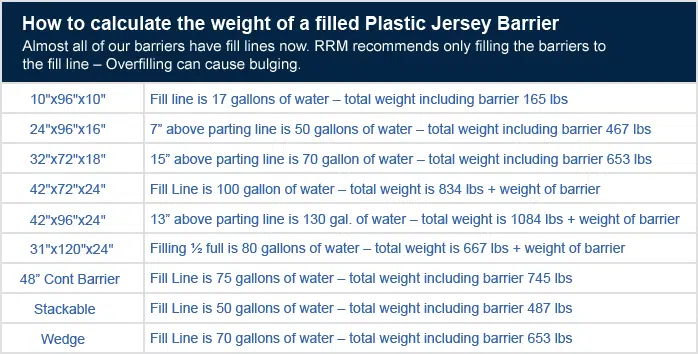
How much will your Plastic Jersey barriers weigh when filled with either water or sand? That will depend on a number of different factors:
- The model and size of the barrier
- Whether you fill the barrier with water or sand
- If filling with sand, the type of sand
- How much water or sand you put in the barrier
The following chart shows our barricade models, with estimates of how much they will weigh when filled with water and sand. To calculate these weights, we multiplied the inside-volume cubic feet of the barricade times the pounds-per-cubic-foot weight of the substance.

Notes:
–The water-filled and sand-filled weights shown do not include the weight of the empty barricade. To determine the actual weight, add the applicable “empty” plus “filled” columns
–The “Water Filled” weights assume the standard water weight of 62.4 pounds per cubic feet
–The “Sand Filled” weights are based on using sand with a weight of 125 pounds per cubic foot, which is an average weight for well-graded sand. If you use fine or medium sands, the weight per cubic foot will be less.
–These estimated weights are based on a scenario in which the entire barricade is filled with sand or water. Total weights will be lower if the barricade is filled only partially.
How to calculate based on the weight per cubic feet of your substance
–If you know the weight-per-cubic-foot of the substance you will use to place inside of your barriers, you can multiply that weight by the number in the “Inside Volume, Cubic Feet” column to arrive at how much your barriers will weigh when filled with the substance.
For example, for Model JB-13, if your substance weighs 100 pounds per cubic foot, the total weight of your barrier will be 2,890:
- 100 pound substance x 27.2 cubic feet = 2,720
- Plus the “weight empty” of 170 pounds = 2,890
